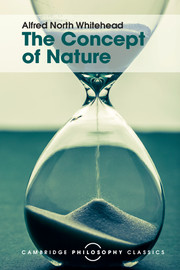5 - Space and motion
Published online by Cambridge University Press: 05 November 2015
Summary
The topic for this lecture is the continuation of the task of explaining the construction of spaces as abstracts from the facts of nature. It was noted at the close of the previous lecture that the question of congruence had not been considered, nor had the construction of a timeless space which should correlate the successive momentary spaces of a given time-system. Furthermore it was also noted that there were many spatial abstractive elements which we had not yet defined. We will first consider the definition of some of these abstractive elements, namely the definitions of solids, of areas, and of routes. By a ‘route’ I mean a linear segment, whether straight or curved. The exposition of these definitions and the preliminary explanations necessary will, I hope, serve as a general explanation of the function of event-particles in the analysis of nature.
We note that event-particles have ‘position’ in respect to each other. In the last lecture I explained that ‘position’ was quality gained by a spatial element in virtue of the intersecting moments which covered it. Thus each event-particle has position in this sense. The simplest mode of expressing the position in nature of an event-particle is by first fixing on any definite time-system. Call it α. There will be one moment of the temporal series of α which covers the given event-particle. Thus the position of the event-particle in the temporal series α is defined by this moment, which we will call M. The position of the particle in the space of M is then fixed in the ordinary way by three levels which intersect in it and in it only. This procedure of fixing the position of an event-particle shows that the aggregate of event-particles forms a four-dimensional manifold. A finite event occupies a limited chunk of this manifold in a sense which I now proceed to explain.
Let e be any given event. The manifold of event-particles falls into three sets in reference to e. Each event-particle is a group of equal abstractive sets and each abstractive set towards its small-end is composed of smaller and smaller finite events. When we select from these finite events which enter into the make-up of a given event-particle those which are small enough, one of three cases must occur.
- Type
- Chapter
- Information
- The Concept of NatureTarner Lectures, pp. 65 - 77Publisher: Cambridge University PressPrint publication year: 2015



